How Owning Great Danes Turned My Home into a Jurassic Bark
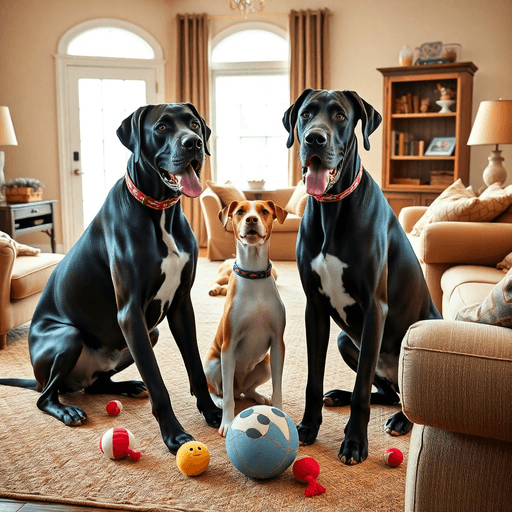
Owning Multiple Great Danes
Owning multiple Great Danes requires substantial space allocation of 80-100 square feet per dog, specialized equipment rated for 200 pounds or more, and daily food costs ranging from $8 to $ 15 per dog. We must implement staggered exercise protocols, synchronized veterinary schedules, and structured social hierarchy management to prevent dominance behaviors. Emergency preparedness protocols become critical with multiple giant breeds, requiring 3-4 hours daily for feeding, exercise, and health monitoring. Understanding these complex care requirements will help you establish thorough management strategies.
Key Takeaways
- Provide 80-100 square feet of indoor space per dog and a minimum of 1,000 square feet of outdoor space with six-foot fencing.
- Budget $300-$ 450 monthly for food costs alone, with each dog requiring 6-10 cups of high-quality kibble per day.
- Dedicate 3-4 hours daily for staggered feeding schedules, exercise rotations, and coordinated health monitoring routines.
- Use controlled parallel walks and supervised play sessions to manage pack dynamics and prevent competitive behaviors.
- Establish emergency protocols and maintain heavy-duty equipment, including leashes rated at 200 pounds or more and extra-large crates.
Space Requirements for Housing Multiple Great Danes
When considering the spatial requirements for multiple Great Danes, it is essential to acknowledge that these dogs require considerably more living space than smaller breeds due to their substantial size and high exercise needs.
Indoor space calculations should allocate approximately 80-100 square feet per dog for ideal movement and rest. Living arrangements must accommodate orthopedic sleeping areas and feature a suitable room layout that prevents territorial disputes.
Outdoor space requirements mandate a minimum yard dimension of 1,000 square feet for two dogs, with secure fencing that exceeds six feet in height.
Dog-friendly furniture should feature elevated surfaces to prevent joint stress and strain. Noise considerations become particularly critical in multi-dog households, necessitating the use of sound-dampening materials.
Adequate ventilation needs increase proportionally with occupancy to maintain air quality standards. Additionally, ensuring adequate exercise is crucial to maintaining the health and happiness of Great Danes in a shared space.
Managing Exercise Needs With Several Giant Dogs
Beyond providing adequate housing space, we must address the complex physiological demands of exercising multiple Great Danes simultaneously. Giant breeds require modified exercise schedules due to their predisposition to orthopedic conditions and cardiovascular stress.
We’ll implement staggered walking rotations, preventing pack mentality overexertion while ensuring individual attention to each dog’s metabolic needs.
Group activities must be carefully monitored, as Great Danes exhibit variable energy levels and exercise tolerance. We recommend controlled parallel walks rather than free-play sessions, which can trigger competitive behaviors leading to joint trauma.
Implementing heart rate monitoring during exercise sessions helps identify early signs of cardiac stress. Swimming provides excellent low-impact cardiovascular conditioning when available.
Each dog’s exercise protocol should be individualized based on age, weight, and existing musculoskeletal health status to prevent exercise-induced injuries. Additionally, structured activities such as interactive play sessions can enhance both mental stimulation and physical fitness.
Financial Costs of Feeding Multiple Great Danes
We must calculate the substantial nutritional expenditures associated with maintaining multiple Great Danes, as adult specimens require 6-10 cups of high-quality kibble daily, which translates to $3-5 per dog per day. You’ll find that bulk purchasing strategies can reduce per-unit costs by 15-25% when buying 40-50 pound bags versus smaller quantities. We recommend establishing precise feeding protocols and budget allocations, as a household with three Great Danes typically incurs $300-$ 450 in monthly food costs alone. Additionally, understanding caloric requirements is crucial to ensure each dog receives the appropriate nutrition for their health and weight needs.
Daily Food Costs
Multiple Great Danes present substantial daily nutritional expenses that require careful financial planning and budgeting.
We’re looking at approximately $8-$15 per dog per day, depending on the quality of food and individual metabolic requirements. Each adult Great Dane consumes 6-12 cups of high-quality kibble daily, translating to significant monthly expenditures when multiplied across multiple dogs.
Effective meal planning ensures ideal nutrition while maintaining accurate budget tracking. Portion control becomes critical for preventing overfeeding and associated healthcare costs.
- Premium kibble brands: $80-120 monthly per dog for veterinary-recommended formulations
- Supplemental protein sources: Raw meat additions averaging $30-50 monthly per dog
- Food variety rotation: Alternating proteins prevents dietary sensitivities while managing costs
- Bulk purchasing strategies: Wholesale buying reduces per-pound costs by 15-25%
Additionally, ensuring that the dog food contains high-quality protein is essential for muscle development and overall health in Great Danes.
Bulk Purchasing Benefits
Strategic bulk purchasing significantly reduces per-unit feeding costs when managing multiple Great Danes, with documented savings ranging from 15-30% compared to standard retail purchases.
We’ll enhance your bulk buying approach by establishing relationships with commercial pet food distributors who offer volume discounts on premium formulations.
Purchase 50-pound bags rather than smaller quantities, as the cost per pound decreases considerably with larger volumes.
Your savings strategy should include joining warehouse clubs and negotiating directly with manufacturers for monthly deliveries.
Calculate monthly consumption rates across all dogs to determine ideal order quantities.
Store dry kibble in airtight containers to maintain nutritional integrity and prevent spoilage.
This systematic approach maximizes financial efficiency while ensuring consistent, high-quality nutrition for your pack. Additionally, keeping human food out of reach is essential to prevent accidental ingestion of harmful items, which is particularly important when feeding multiple dogs.
Veterinary Care Considerations for Multiple Dogs
When managing healthcare for multiple Great Danes, veterinary costs escalate considerably due to their size-related medication dosing, increased anesthetic requirements, and predisposition to breed-specific conditions like gastric dilatation-volvulus and dilated cardiomyopathy.
We’ll need to establish synchronized vaccination schedules and implement thorough preventive health protocols across all dogs. Their nutrition needs require careful monitoring to prevent developmental orthopedic diseases, while parasite control becomes more complex with multiple animals sharing environments.
- Emergency protocols: Establish relationships with 24-hour veterinary facilities capable of handling giant breeds.
- Dental care: Schedule staggered professional cleanings to manage anesthetic costs and recovery supervision.
- Breed-specific issues: Implement cardiac screening schedules and gastropexy consultations for each dog.
- Grooming routines: Coordinate nail trims and ear cleaning to identify health issues early across multiple dogs. Additionally, regular veterinary check-ups are vital for monitoring heartworm status in all dogs, ensuring early detection and effective treatment.
Training Challenges With More Than One Great Dane
Training multiple Great Danes presents distinct behavioral management challenges that require evidence-based approaches to prevent dominance hierarchies and resource guarding behaviors. We must implement simultaneous training protocols that address individual dog responses while maintaining pack cohesion through structured leadership techniques. Research demonstrates that multi-dog households experience increased incidence of redirected aggression and competitive behaviors without proper behavioral conditioning strategies. Additionally, early socialization is crucial for ensuring that each dog develops positive interactions with its peers and the environment.
Managing Multiple Dogs Simultaneously
Although single Great Dane training presents considerable challenges due to their size and strength, multi-dog households exponentially increase complexity through pack dynamics and intercanine behavioral interference.
We must implement structured protocols to maintain control during simultaneous management sessions.
Effective multi-dog coordination requires systematic approaches to prevent behavioral cascades and resource guarding incidents:
- Establish separate feeding schedules with physical barriers to eliminate competition-based aggression
- Implement staggered grooming needs appointments to reduce stress and maintain individual attention
- Schedule alternating doggy daycare sessions to prevent pack mentality reinforcement during socialization
- Design parallel training techniques using positive reinforcement while maintaining adequate spacing
During playtime routines, we should conduct continuous behavior observation to identify early intervention opportunities.
Travel considerations become exponentially complex, requiring specialized equipment and enhanced health tracking protocols.
Strategic bonding activities strengthen individual relationships while effectively managing group dynamics. Additionally, understanding the importance of early socialization can significantly improve training outcomes in a multi-dog environment.
Preventing Pack Behavior Issues
Pack behavior manifestations in multi-Great Dane households present distinct neurological and social challenges that require immediate intervention protocols. We must implement systematic behavior modification techniques to prevent resource guarding, territorial aggression, and dominance displays. Establishing a clear pack hierarchy through structured training prevents the escalation of competitive behaviors between dogs. Great Danes thrive on human interaction and companionship, making it essential to manage their social needs effectively.
| Intervention Protocol | Implementation Method |
|---|---|
| Resource Management | Separate feeding stations, individual toy allocation |
| Hierarchical Training | Alpha-designated commands, sequential obedience practice |
| Space Delineation | Designated sleeping areas, controlled territory access |
| Socialization Control | Supervised interactions, gradual exposure protocols |
| Behavioral Monitoring | Daily assessment logs, aggression trigger identification |
Early detection of pack dynamics enables proactive management. We’ll establish individual training sessions before group exercises, ensuring each Great Dane responds independently to commands rather than following pack instincts.
Social Dynamics Between Multiple Great Danes
When Great Danes cohabitate within the same household, their social hierarchies are established through subtle behavioral cues rather than overt dominance displays.
Unlike smaller breeds that rely on aggressive posturing, Great Danes negotiate their household pecking order through gentle, almost imperceptible social signals.
We’ll observe these gentle giants developing intricate communication cues that maintain the stability of the pack mentality. Their dominance hierarchy emerges through controlled, playful interactions and strategic positioning during the distribution of shared resources.
Social bonding strengthens through coordinated group activities, while conflict resolution occurs through displacement behaviors and spatial awareness. These dogs demonstrate remarkable emotional intelligence when maneuvering inter-canine relationships.
- Resource allocation protocols: Established feeding sequences and territory boundaries minimize competition
- Behavioral mirroring patterns: Synchronized movement and activity levels indicate successful pack integration
- Stress indicator monitoring: Excessive panting, displacement behaviors, or withdrawn postures signal social tension
- Positive reinforcement scheduling: Reward-based training sessions strengthen cooperative behaviors and reduce territorial disputes.
Additionally, Great Danes are known for their size and gentleness, which further enhances their ability to coexist harmoniously in a multi-dog environment.
Safety Considerations With Children and Multiple Large Dogs
When children interact with multiple Great Danes, we must implement strict supervision protocols to prevent accidental injury from these 100-200 pound canines whose exuberant movements can easily overwhelm smaller family members.
Pack behavior modifications occur when multiple dogs are present, requiring us to establish clear hierarchical boundaries and intervention strategies to maintain controlled interactions.
We recommend developing thorough emergency action plans that include rapid dog separation techniques and immediate medical response procedures for households with children and multiple large-breed dogs.
Supervised Play Sessions Essential
Although Great Danes possess gentle temperaments, their considerable size and strength require constant supervision during interactions with children, particularly in multi-dog households.
We must implement structured playtime supervision protocols to prevent inadvertent injuries from enthusiastic canine behavior. Multiple Great Danes can amplify excitement levels during group interactions, potentially overwhelming younger children due to their sheer physical presence.
Evidence suggests that supervised sessions significantly reduce incident rates when proper boundaries are established.
We recommend implementing these safety measures:
- Maintain visual contact with all participants during play sessions
- Establish designated play zones with adequate space for movement
- Monitor canine arousal levels and intervene before overstimulation occurs
- Teach children appropriate interaction techniques and boundary recognition
Consistent supervision guarantees positive experiences while mitigating risks inherent in large-breed group dynamics.
Managing Pack Dynamics
Since multiple Great Danes naturally establish hierarchical relationships within household environments, we must understand these pack dynamics to guarantee that children’s safety remains paramount.
Pack hierarchy develops through resource competition, territorial behaviors, and dominance displays that can inadvertently endanger young family members.
We’ll observe role distribution patterns where alpha dogs may exhibit protective aggression or resource guarding around children. Beta and subordinate dogs might display redirected frustration or arousal behaviors during hierarchical disputes.
Children can’t interpret these canine social signals effectively, positioning them at risk during periods of pack restructuring.
We must implement strict management protocols: separate feeding stations, controlled interactions during status challenges, and immediate intervention when tension escalates.
Professional behavioral assessment becomes essential when multiple large breeds demonstrate unstable pack dynamics around vulnerable household members.
Emergency Response Planning
Given that multiple Great Danes present exponential risk factors compared to single-dog households, we must establish thorough emergency response protocols that address worst-case scenarios involving children.
Systematic preparation minimizes response time during critical incidents where large canines may inadvertently cause harm through size disparity alone.
Essential emergency contacts must include veterinary emergency services, pediatric urgent care, and animal control authorities.
Disaster preparedness requires coordinated evacuation procedures that accommodate multiple animals weighing over 150 pounds alongside family members.
- Rapid restraint protocols: Pre-positioned slip leads and barriers for immediate dog containment during medical emergencies
- Communication systems: Hands-free devices enabling simultaneous emergency service coordination and dog management
- Medical intervention supplies: Pediatric first aid kits positioned throughout multi-dog zones
- Evacuation logistics: Vehicle capacity assessment and transport crating systems for emergency relocations
Equipment and Supply Needs for Several Giant Breeds
Multiple Great Danes require substantially larger quantities of specialized equipment compared to smaller breeds, with each dog needing appropriately sized gear to accommodate their height range of 28-34 inches and weight range of 110-175 pounds.
Owning multiple Great Danes demands significant investment in oversized, heavy-duty equipment specifically engineered for giant breed requirements.
We must invest in heavy-duty leashes rated for 200 pounds or more, reinforced collars with sturdy hardware, and extra-large crates measuring a minimum of 54 inches x 37 inches x 45 inches per dog.
Grooming tools must include wide-tooth combs, large slicker brushes, and nail clippers designed for giant breeds.
Training supplies require long leads, heavy-duty treat pouches, and large training mats.
Vehicle modifications like cargo barriers and non-slip surfaces become essential for the safe transportation of multiple giant breeds.
Time Management for Multiple Great Dane Care
Although Great Danes are generally low-maintenance in terms of grooming and exercise compared to other breeds, caring for multiple giants requires systematic time allocation and structured daily routines to meet their substantial physiological needs.
Effective scheduling routines require dedicating 3-4 hours daily for feeding protocols, exercise regimens, and health monitoring. Task prioritization becomes critical when managing gastric dilatation-volvulus prevention measures and orthopedic assessments across multiple dogs.
Crucial time management strategies include:
- Implementing staggered feeding schedules to prevent resource guarding and monitor individual dietary intake
- Establishing sequential exercise rotations to guarantee adequate cardiovascular conditioning while preventing overexertion
- Conducting systematic health evaluations, including joint palpation and gait analysis
- Coordinating veterinary appointments and medication administration schedules
We recommend creating detailed time blocks for each dog’s specific needs, allowing for flexibility in emergency interventions while maintaining consistent care standards.
Health Monitoring Across Multiple Great Danes
Since Great Danes exhibit breed-specific predispositions to dilated cardiomyopathy, gastric dilatation-volvulus, and developmental orthopedic diseases, systematic health surveillance becomes exponentially complex when monitoring multiple dogs simultaneously.
We’ll establish individualized medical protocols that address each dog’s genetic predispositions while maintaining collective oversight. Staggered routine check-ups prevent veterinary bottlenecks and ensure consistent monitoring.
We’ll implement thorough weight management systems, tracking each dog’s body condition score to prevent orthopedic complications. Dietary needs require individual assessment based on age, activity level, and existing health conditions.
Synchronized vaccination schedules streamline immunization protocols while maintaining peak protection intervals. Digital health records enable the tracking of breed-specific issues across our pack.
Implementing structured preventive measures, including cardiac screenings and gastric risk assessments, guarantees early detection of developing pathologies.
Questions
What Age Gap Is Ideal Between Multiple Great Danes?
We recommend maintaining a two- to three-year age gap between Great Danes. This interval optimizes puppy dynamics by ensuring the older dog’s behavioral maturity while considering age considerations that prevent overwhelming territorial competition and resource guarding behaviors.
How Do You Handle Traveling With Multiple Great Danes?
Like orchestrating a symphony of giants, we’ll share evidence-based travel tips: utilize appropriately sized dog crates for skeletal support, maintain hydration protocols, and implement systematic rest intervals to prevent cardiovascular stress during transport.
Should You Get Male and Female Great Danes Together?
We recommend considering male vs female pairings carefully. Mixed-gender pairs typically exhibit complementary bonding behaviors and reduced same-sex aggression. However, spaying or neutering prevents unwanted breeding while maintaining ideal social dynamics between your dogs.
What’s the Maximum Number of Great Danes One Household Should Have?
Studies show 80% of multi-dog households experience behavioral issues with three or more dogs. We recommend limiting household capacity to two Great Danes maximum, as breed compatibility decreases markedly when adding additional giant breeds.
How Do You Introduce a New Great Dane to Existing Dogs?
We recommend implementing gradual introduction techniques through controlled neutral territory meetings. Evidence-based socialization strategies include supervised parallel walks, separated feeding protocols, and progressive proximity increases. A veterinary consultation ensures an ideal behavioral assessment before establishing permanent cohabitation arrangements.
Final Thoughts
Like shepherds tending multiple giants in our care, we’ve navigated the complex pathophysiology of multi-Great Dane ownership. Each consideration—from spatial requirements to cardiac monitoring—represents critical variables in our clinical management equation. We’re not merely pet owners; we’re veterinary advocates orchestrating extensive care protocols. The prognosis for successful multiple Great Dane stewardship depends on our rigorous adherence to evidence-based husbandry practices, financial preparedness, and an unwavering commitment to the well-being of these gentle giants.
References
- https://www.akc.org/dog-breeds/great-dane/
- https://www.dogster.com/dog-breeds/will-great-dane-be-good-with-another-dog
- https://www.sniffspot.com/blog/dog-breeds/explore-the-great-dane-genuine-tips-from-9000-owners
- https://www.pawlicy.com/blog/us-pet-ownership-statistics/
- https://en.wikipedia.org/wiki/Great_Dane
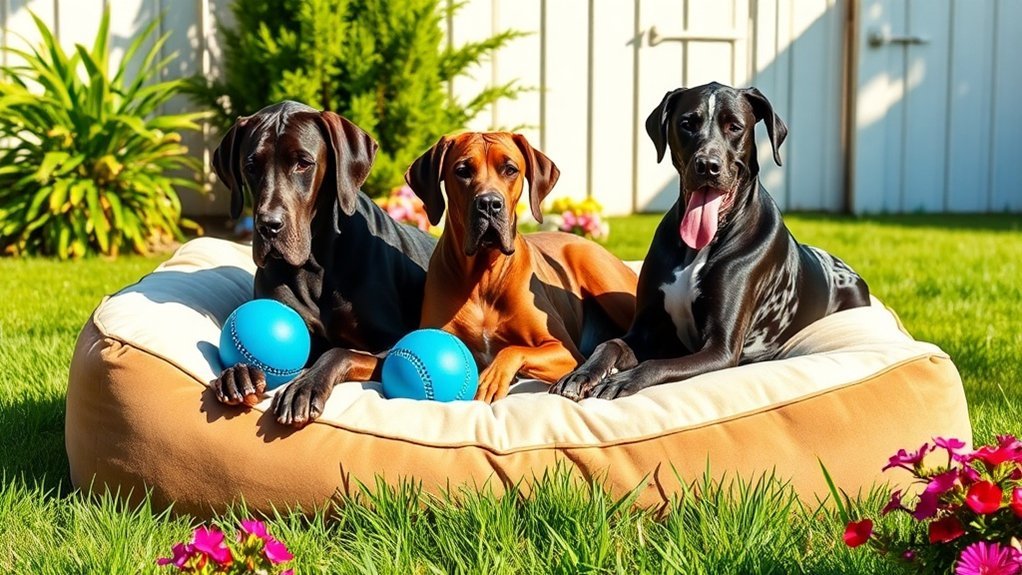
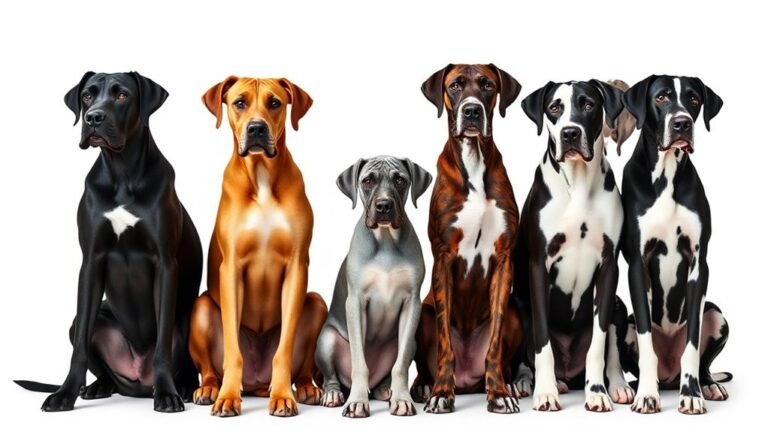
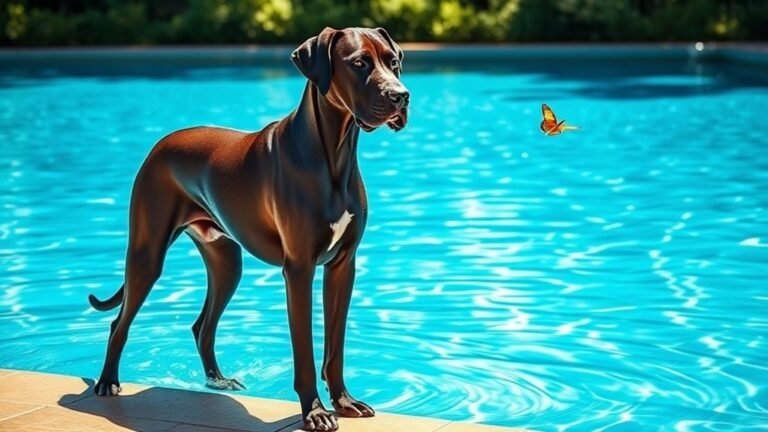
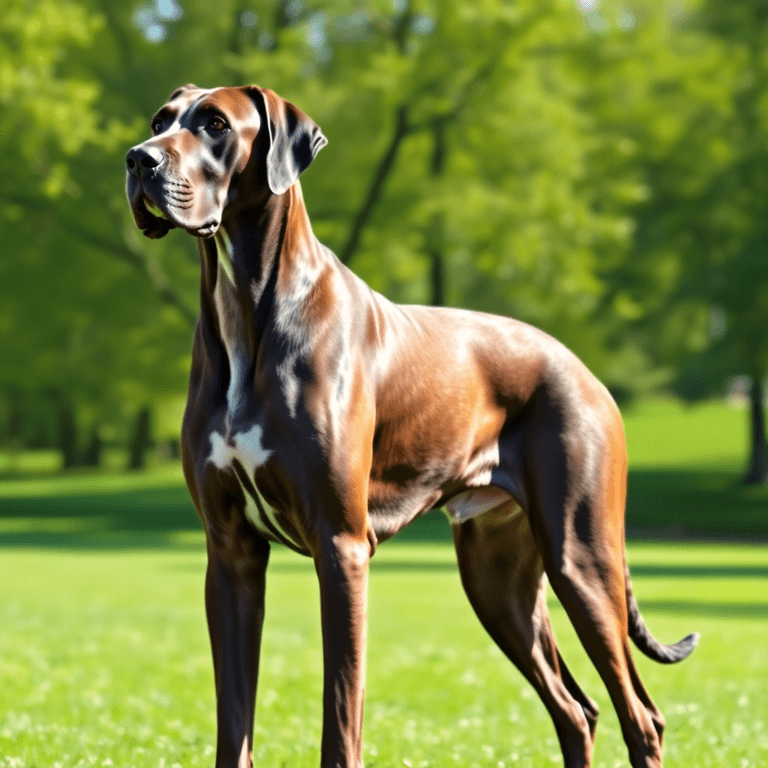


19 Comments